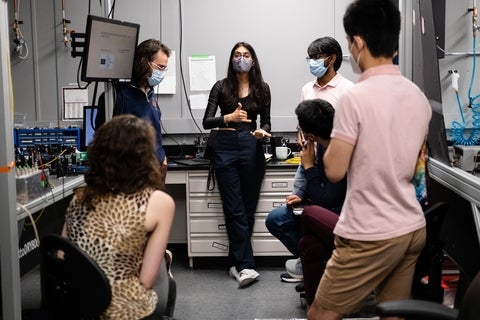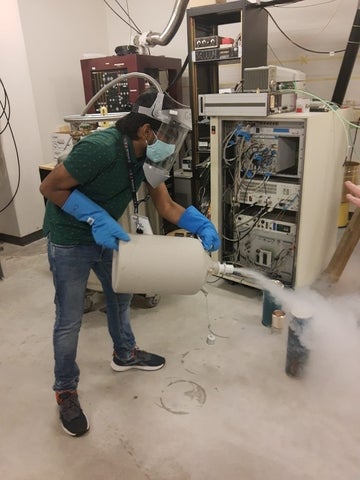Each year, the Institute for Quantum Computing (IQC) invites top undergraduate students from around the world to the University of Waterloo for the opportunity to immerse themselves in quantum information science and technology. This program, the Undergraduate School on Experimental Quantum Information Processing (USEQIP), provides participants with lectures on quantum information theory and experimental approaches to quantum devices, as well as over 30 hours of hands-on laboratory and experimental exploration.
Following this program, many of the participants stay for the remainder of the summer to work with an IQC faculty member on a research project. These opportunities expose the students to cutting-edge research questions, state-of –the-art facilities, and leading experts in quantum information. In turn, the students bring a variety of experiences and talent to IQC each year and continue to promote the Institute as a leading destination worldwide for quantum research and talent development.
“It’s great to see the enthusiasm of our USEQIP students each summer and see how their research evolves,” says Dr. Adrian Lupascu, an IQC faculty member and professor in Waterloo’s Department of Physics and Astronomy. “When their work reaches publication, it’s a great achievement, especially for a junior researcher.”

In the summer of 2022, one of these talented USEQIP participants was Mahadevan Subramanian. Working with Lupascu, Subramanian undertook a theoretical research project with the goal of finding the best way to entangle two qutrits, quantum systems with three possible states.
“Working with Dr. Lupascu inspired me to go to graduate school,” says Subramanian. “When I was at Waterloo, we were trying to understand how a superconducting transmons can be used for quantum information.”
Superconducting transmons are a type of superconducting circuit that is less sensitive to noise, and can be used to hold quantum information. While a great deal of research only considers two possible energy levels in order to build qubits, transmons have many other energy levels available to encode information. Subramanian was specifically considering transmons with three levels for storing quantum information, known as qutrits. Expanding a quantum system from binary systems (which can store information as only a 0 or 1) to multiple levels holds significant advantages for future quantum computers.

“By the end of my summer research, a large part of what I realized was we can find a way to decompose a CZ gate into the kind of gates I can get out of my simple capacitive circuit,” said Subramanian. “We’re using a three transmon system where one is tunable and the other two are fixed frequency. By controlling the magnetic flux of the tunable transmon to oscillate at the resonance frequency between two particular energy levels of the fixed transmons, we can create a population exchange between them, and move the system towards entanglement.”
Entanglement is a key component of future quantum computers, so finding new, efficient, and scalable ways to entangle qutrits is an important step towards the goal of realizing a future quantum computer. Subramanian and Lupascu have found a new theoretical process for implementing CZ gates for qutrits, presenting a method for fast, scalable entanglement.
“What I like about the field of quantum information is how interdisciplinary it is, and how learning one thing also helps you understand other areas as well,” says Subramanian. “There is still a lot to discover in the field of superconducting transmons, which is really something to think about, given how rapidly the progress is happening with all the research focused on transmons right now.”
Subramanian and Lupascu’s research, Efficient two-qutrit gates in superconducting circuits using parametric coupling, was recently published in Physical Review A. Applications for USEQIP are due in January each year for participation in the summer program. Learn more about USEQIP or sign up to receive information about 2025 registrations on the USEQIP webpage.
Intriquer des étudiants de premier cycle avec la réussite quantique
Chaque année, l’Institut d’informatique quantique (IQC) invite la crème des étudiants de premier cycle des quatre coins du monde à l’Université de Waterloo pour une immersion en informatique et en technologie quantiques. Dans le cadre de ce programme, la Undergraduate School on Experimental Quantum Information Processing (USEQIP), les participants suivent des cours sur la théorie de l’information quantique et des approches expérimentales des appareils quantiques, et profitent de plus de 30 heures d’exploration expérimentale en laboratoire.
Après ce programme, bon nombre de participants restent à l’IQC et travaillent sur un projet de recherche avec un membre du corps professoral pour le reste de l’été. C’est une occasion pour les étudiants de s’initier à des questions de recherche de pointe, d’utiliser des installations dernier cri et de rencontrer d’éminents spécialistes de l’information quantique. À leur tour, les étudiants apportent une pluralité d’expériences et de talents à l’IQC chaque année et continuent d’en faire la promotion comme destination mondiale de premier plan pour la recherche quantique et l’éclosion de talents.
« Quel bonheur de voir l’enthousiasme et l’évolution de la recherche de nos étudiants de l’USEQIP chaque été! s’exclame Adrian Lupascu, Ph. D., membre du corps professoral de l’IQC et professeur au Département de physique et d’astronomie de l’Université de Waterloo. L’étape de la publication est une réussite considérable, surtout pour un jeune chercheur. »

À l’été 2022, Mahadevan Subramanian était l’une des talentueuses recrues de l’USEQIP. Travaillant aux côtés d’Adrian Lupascu, il a entrepris un projet de recherche théorique visant à trouver la meilleure manière d’intriquer deux qutrits, des systèmes quantiques de trois états possibles.
« Mon travail avec le professeur Lupascu m’a donné envie de poursuivre mes études au deuxième cycle, révèle Mahadevan Subramanian. À l’Université de Waterloo, nous tentions d’élucider comment un transmon supraconducteur peut servir à contenir de l’information quantique. »
Les transmons supraconducteurs sont un type de circuit supraconducteur moins sensible au bruit qui peut contenir de l’information quantique. Si un grand nombre de travaux se penchent strictement sur deux niveaux d’énergie pour bâtir des qubits, les transmons ont bien d’autres niveaux d’énergie capables d’encoder de l’information. Mahadevan Subramanian a étudié les transmons à trois états capables de stocker de l’information quantique, appelés les qutrits. Le passage d’un système quantique binaire (capable de stocker des zéros et des uns seulement) à des systèmes à multiples niveaux a d’importants avantages pour les futurs ordinateurs quantiques.

« À la fin de ma recherche d’été, j’ai notamment réalisé que nous pouvions trouver une façon de décomposer une porte quantique contrôlée-z en un type de portes que l’on peut obtenir d’un circuit capacitif simple, explique l’étudiant. Nous utilisons un système à trois transmons : un réglable et deux fixes. En ajustant le flux d’énergie du transmon réglable à la fréquence de résonance située entre les deux niveaux des transmons fixes, nous pouvions créer un échange de population entre ces derniers et rapprocher le système de l’intrication. »
L’intrication étant un élément clé de l’avenir des ordinateurs quantiques, la découverte de nouveaux moyens efficaces et adaptables d’intriquer les qutrits est une étape importante de la création d’un éventuel ordinateur quantique. Mahadevan Subramanian et le professeur Lupascu ont trouvé un nouveau processus théorique permettant de créer des portes contrôlées-z pour les qutrits, une méthode d’intrication rapide et modulable.
« Ce que j’aime particulièrement du domaine de l’information quantique, c’est sa dimension interdisciplinaire, et le fait que l’apprentissage d’un élément aide à comprendre d’autres facettes, explique Mahadevan Subramanian. Il y a encore beaucoup à découvrir dans le domaine des transmons supraconducteurs, ce qui donne à réfléchir étant donné le progrès rapide de toute la recherche en cours sur les transmons. »
L’étude de Mahadevan Subramanian et du professeur Lupascu, « Efficient two-qutrit gates in superconducting circuits using parametric coupling », a récemment été publiée dans la revue Physical Review A. Les demandes pour la participation au programme d’été de l’USEQIP doivent être envoyées au plus tard en janvier. Pour en savoir plus ou pour recevoir de l’information sur les inscriptions de 2025, rendez-vous sur la page Web de l’USEQIP.